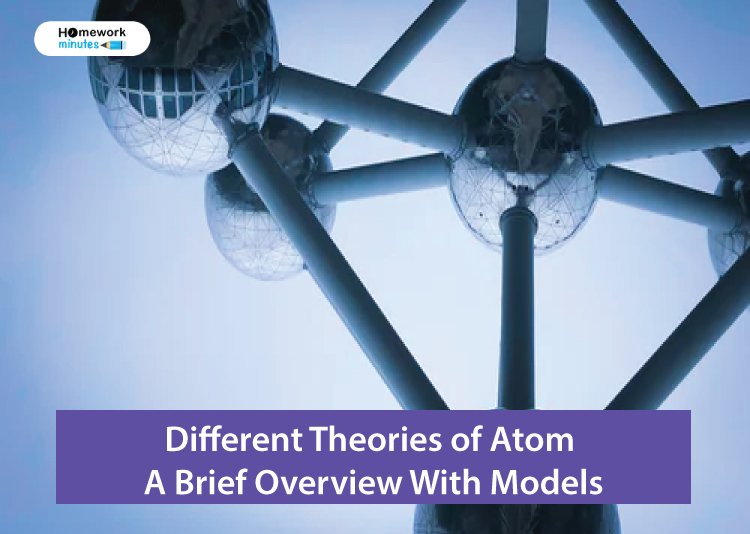Did you know? The atom’s concept as an indivisible building block of matter falls back in the early 5th century BCE. Before any theories of the atom came into being, many rough concepts of the building block of matter came up by the test and trial by many chemists. What are these theories that led to the modern theory of an atom? In this blog, you’ll learn the same.
Also read:-
4 Types of Chemical Bonds | Chemistry Homework Help
History of Atomic Theory
The ancient Greek philosophers, Democritus and Leucippus, were the first to record the atoms’ concept. Preceding that, the atomic theory timeline started with discoveries from different scientists. These scientists brought up and defined different cases, such as why iron is solid, and water is liquid at room temperature. Democritus, in particular, described that all matter is composed of tiny indestructible units called atoms. These particles remain unchanged but travel about in space to combine various ways to form all macroscopic objects.
Dalton’s Atomic Theory – Solid Sphere Model
In 1808, English Chemist John Dalton set his learning to give a notion on the atom down the memory lane. He postulated that matter is made of the atoms, which are small indivisible particles. Dalton’s Atomic Theory further proposed that although all atoms of an element are quite identical. However, they are distinct from other elements that constitute the other elements. The main laws that John Dalton’s Atomic Theory used include – the law of conservation of mass and the law of constant proportion. Hence, John Dalton’s model got its name as a ‘Solid Sphere Model.’
J.J. Thomson Atomic Theory – The Plum Pudding Model
The second theory in the atomic theory timeline is Thomson’s Atomic Theory. In 1904, the English physicist Joseph J. Thomson proposed the “plum pudding” theory of the divisible atom, after discovering electrons in 1897. According to this theory, the atoms consist of a big positively-charged sphere with negatively charged electrons studded in it with negatively charged electrons called corpuscles. Thomson called his model the plum pudding model with design that of fruits in a plum pudding. Further, he declared that the positive sphere’s charge is equal to the negative charges of the electrons. These positively and negatively charged
today have names as protons and electrons, respectively.
Rutherford’s Atomic Theory – Nuclear Model
In 1911, British physicist Ernest Rutherford proposed a nuclear model of the atom that comprised the nucleus. During his hypothesis, he conducted an experiment in which protons and electrons’ movement took place within the central portion of the atom. Further, he also postulated that the number of protons in an atom equals the number of electrons in the same atom. The add on that he gave, which supported the future theories, was the discovery of neutrons.
Niels Bohr Atomic Theory – Planetary Model
The next theory in line is Bohr’s theory. In 1913, Bohr proposed his theory in which electrons revolve around the nucleus like planets orbit the sun. According to Bohr, these orbiting electrons have an amount of energy called “constant energy.” The particles in an atom, in turn, absorb this energy and transition into a higher orbit and get termed as “excited” electrons. This model of Bohr came to be known as ‘The planetary model.’
Modern Theory of an Atom
After tremendous efforts by thousands of scientists, the modern theory of the atom comprises the postulates by Albert Einstein, Heisenberg, and Quantum Mechanics. The modern theory rejects the prior solid structure of the atom. Instead of electrons orbiting around the elliptical path, they are in various cloud shapes. Hence, as a result, despite being a solid matter, exhibit wavelike properties such as wavelength and interference pattern.
Quark Theory
With further theories, scientists look at atoms with better powerful instruments. According to the Quark theory, protons and neutrons that are made up of a nucleus are made of smaller particles. According to this theory, in 1960, physicists Murray Gell-Mann and George Zweig called ‘quarks,’ taking inspiration from James Joyce’s novel. As per the description, both Quarks and Protons/Neutrons have one thing in common, both have varieties such as “up, “down” and “up” and “down,” “up” and “down,” respectively.
Five Types of Atomic Models in a Nutshell
After reading about all the atomic theories, there are five types of atomic models derived out of it. Because of the discoveries and experiments by various scientists, the final theory of atom came into being.
- Early Spherical Model
- Plum Pudding Model
- Two Planetary Orbit Model
- Electron Cloud Model
If you need any help with more such chemistry topics or other science-related topics, you can seek instant online assignment help from us. Our team has professionals who can help you write 100% top-quality assignments with zero-plagiarism. Chat with us now!
Related Questions
Devry NR707 2019 September Week 7 Project Implementation Presentation Latest


